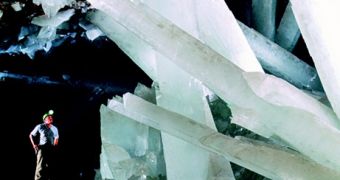This is one of the most beautiful natural wonders. Mexico's Cueva de los Cristales (Cave of Crystals) harbors one of the largest natural crystals ever discovered: translucent gypsum beams up to 36 feet (11 meters) long and weighing up to 55 tons.
Located a thousand feet (300 meters) below Naica mountain in the Chihuahuan Desert (northwestern Mexico), the cave was found by two miners digging a new tunnel for the Industrias Pe?oles company in 2000.
Now, Juan Manuel Garc?a- Ruiz, a geologist of the University of Granada in Spain, and his team have solved the mystery of how the minerals achieved their monumental forms.
The team investigated tiny pockets of fluid trapped inside. "The crystals thrived because they were submerged in mineral-rich water with a very narrow, stable temperature range-around 136 degrees Fahrenheit (58 degrees Celsius)", he said.
At this temperature, the mineral anhydrite, abundant in the water, deposed into gypsum, a soft stone that took the form of the crystals of the cave.
The mining complex in Naica area represents some of the world's largest deposits of silver, zinc, and lead.
In 1910, another spectacular cave was found in the area, the Cave of Swords, located closer to the surface (at 400 ft or 120 m) with the walls adorned with crystal "daggers", about a yard (a meter) long.
The Cave of Crystals has a horseshoe shape, roughly 30 ft (10 m) wide and 90 ft (30 m) long, with the floor covered by crystalline, perfectly faceted blocks, while the huge crystal beams grow up from both the blocks and the floor. "There is no other place on the planet where the mineral world reveals itself in such beauty," Garc?a-Ruiz said.
The volcanoes that erupted about 26 million years ago produced the Naica mountain and filled it with high-temperature anhydrite, the anhydrous (water lacking) variant of gypsum, which is stable above 136 degrees Fahrenheit (58 degrees Celsius).
Below this temperature, it combines with water forming gypsum.
When magma in the center of the mountain cooled below 58 degrees Celsius, the anhydrite dissolved into the waters and deposited in the caves in the form of huge selenite gypsum crystals. "There is no limit to the size a crystal can reach," Garc?a-Ruiz said. "But, for the Cave of Crystals to have grown such gigantic crystals, it must have been kept just below the anhydrite-gypsum transition temperature for many hundreds of thousands of years."
In the Cave of the Swords, this transition temperature could have been much shorter, forming smaller crystals. The occurrence of these conditions elsewhere is remote, but there could be also other caves and caverns at Naica displaying similarly large crystals. "The caves containing larger crystals will be located in deeper levels with temperatures closer to, but no higher than, 58 degrees Celsius. The only reason humans can get into the caves today, however, is because the mining company's pumping operations keep them clear of water. If the pumping is stopped, the caves will again be submerged and the crystals will start growing again," Garc?a-Ruiz said.
"That's an interesting question. Should we continue to pump water to keep the cave available so future generations may admire the crystals? Or should we stop pumping and return the scenario to the natural origin, allowing the crystals to regrow?" he added.

 14 DAY TRIAL //
14 DAY TRIAL //